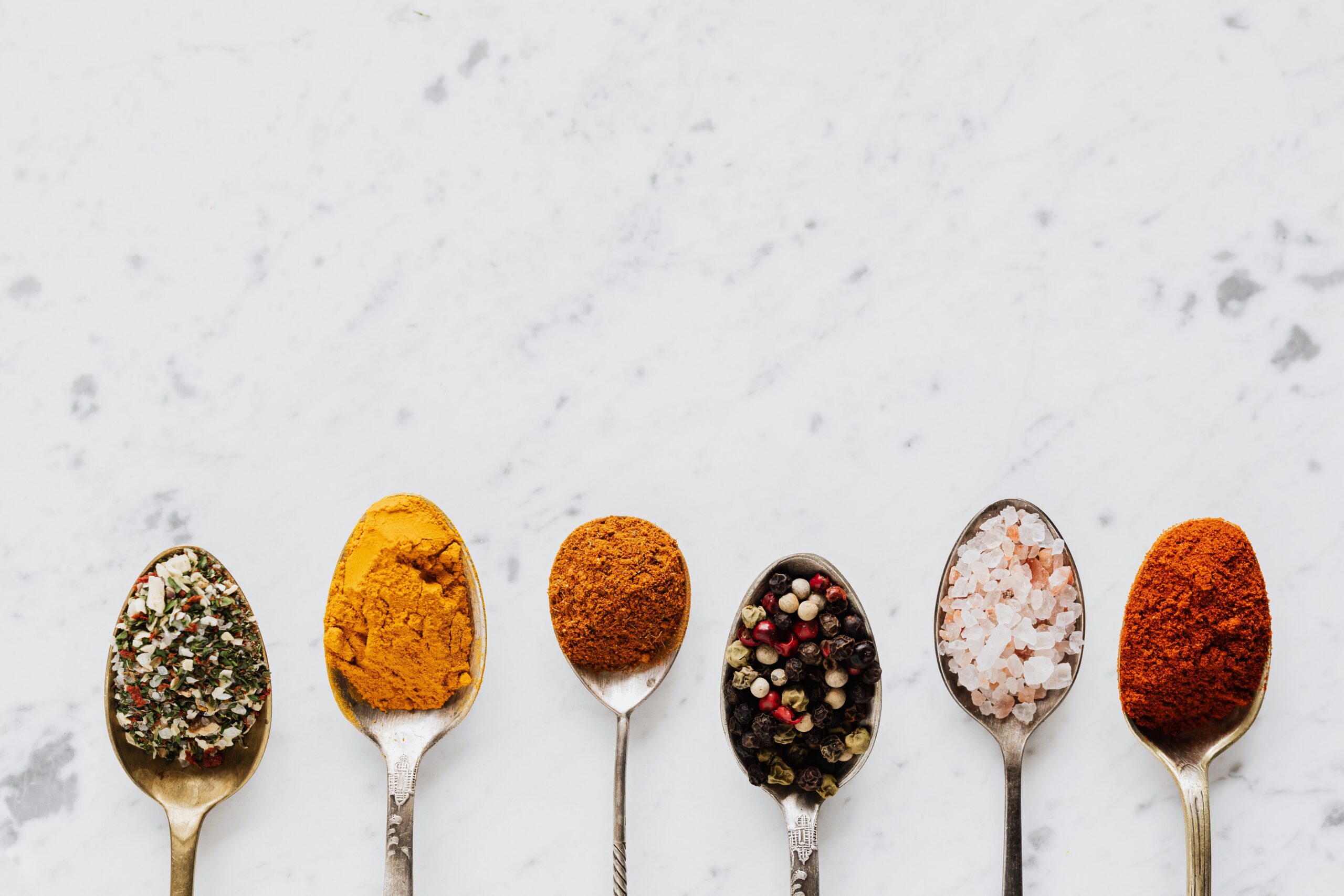
Photo by Karolina Grabowska
Exotic Spices and Herbs
Indian cuisine is renowned for its rich flavors and aroma tapestry, mainly due to the extensive use of various spices and herbs. From the earthy warmth of cumin to the zesty fragrance of curry leaves, Indian cooking is an art form that blends these exotic ingredients to create vibrant and tantalizing dishes. In this culinary adventure, we embark on a journey through a diverse selection of these spices and herbs, each contributing its unique essence to the fascinating world of Indian cuisine.
Alkanet Root
Alkanet root, or ‘Ratanjot,’ is highly regarded for its deep crimson hue. It is a natural food coloring agent, lending a rich and captivating color to dishes like biryanis and tandoori preparations.
Amchoor
Amchoor, or dried mango powder, is cherished for its tart and tangy profile. It plays a pivotal role in many Indian snacks and chaats, elevating the overall flavor with its zesty zest.
Asafoetida
Asafoetida, also known as ‘hing,’ is characterized by its potent and pungent aroma. Used sparingly, it imparts a unique umami flavor to dishes and is a staple in Indian cuisine, particularly in lentil-based recipes.
Bay Leaf (Indian Bay Leaf)
The Bay Leaf, called ‘Tej Patta,’ is renowned for its aromatic qualities. It finds its place in rice dishes, curries, and biryanis, contributing a subtle and earthy fragrance.
Black Cardamom
Black Cardamom, distinct from its green counterpart, offers a smoky and robust flavor. It is frequently employed in hearty dishes such as biryanis and meat curries.
Black Peppercorns
Black Peppercorns reign as the monarchs of spiciness, delivering heat and pungency to dishes. They are used whole and ground, infusing various Indian recipes with a fiery kick.
Charoli
Charoli, also known as ‘Chironji,’ is a nut that introduces a delightful crunch to Indian sweets and savory dishes. It offers a mild, almond-like flavor.
Capers
Capers introduce a briny and tangy element to Indian dishes, especially in recipes featuring rich gravies or sauces. They hold a prominent place in some regional cuisines.
Capsicum or Bell Pepper
Capsicum or Bell Pepper adds vibrant colors and a sweet, crisp texture to various Indian dishes. They are commonly employed in curries, stir-fries, and salads.
Caraway Seeds
Caraway Seeds contribute a subtle, earthy flavor to Indian bread, such as ‘naan’ and ‘paratha.’ They also feature spice blends and specific savory preparations.
Carom Seeds
Carom Seeds, also known as ‘Ajwain,’ possess a robust, slightly bitter flavor. They frequently use bread and lentil dishes and are valued for their digestive properties.
Cassia Buds
Cassia Buds represent the unopened flowers of the cassia tree, offering a sweet and floral essence. They are employed in select spice blends and desserts.
Char Magaz
Char Magaz is a blend of four seeds (watermelon, muskmelon, pumpkin, and cucumber) that often garnishes Indian sweets and desserts, lending a nutty crunch.
Cinnamon
Cinnamon imparts a warm and sweet note to both sweet and savory dishes. It is a fundamental component in spice blends and dessert preparations.
Citric Acid
Citric Acid serves as a souring agent in Indian cooking, particularly in crafting various pickles and chutneys. It enhances the tanginess of these condiments.
Cloves
Cloves are renowned for their intense and pungent flavor. They are utilized sparingly in dishes to provide a bold and spicy punch.
Coriander Seed
Coriander Seed, distinct from fresh cilantro leaves, imparts a citrusy and earthy flavor. It is a foundational spice in Indian cuisine, used in blends and curries.
Cubeb or Tailed Pepper
Cubeb, also known as ‘tailed pepper,’ boasts a distinctive flavor profile encompassing spiciness and a subtle sweetness. It occasionally graces spice mixes and traditional remedies.
Cumin Seed
Cumin Seed offers a warm and earthy essence and is frequently employed in tempering and spice blends. It stands as a cornerstone spice in Indian cooking.
Cumin Seed Ground into Balls
Cumin seeds ground into balls are convenient for infusing dishes with cumin flavor without the need to toast and scrape the seeds. They find their place in a variety of Indian recipes.

Photo by Mareefe
Curry Leaf (Sweet Neem Leaf)
Curry Leaf, known as ‘Kadi Patta,’ is celebrated for its aromatic and slightly citrusy profile. It is indispensable in South Indian cuisine, elevating the flavors of curries and rice dishes.
These exotic spices and herbs are the building blocks of Indian cuisine, each adding unique fragrance, flavor, and personality to various dishes. Whether you’re preparing a fragrant curry, a sumptuous biryani, or a zesty chutney, the inclusion of these spices and herbs contributes depth and complexity to your culinary creations, ensuring that every meal becomes an unforgettable journey through the diverse and flavorful realm of Indian food.



